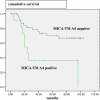Association of MICA-TM and MICB C1_2_A microsatellite polymorphisms with tumor progression in patients with colorectal cancer
- PMID: 19353249
- PMCID: PMC2701994
- DOI: 10.1007/s10875-009-9288-6
Association of MICA-TM and MICB C1_2_A microsatellite polymorphisms with tumor progression in patients with colorectal cancer
Abstract
Purpose: The major histocompatibility complex class I related A (MICA) and MICB molecules are ligands of NKG2D receptors on natural killer cells, gamma/delta T cells, and CD8ass T cells that mediate host antitumor immune response. The role of MICA-TM and MICB C1_2_A alleles in patients with colorectal cancer has not yet been investigated.
Methods: We have analyzed the MICA-TM and MICB C1_2_A polymorphisms in colorectal cancer patients (n = 79) by polymerase chain reaction amplification, subsequent electrophoresis, and sequencing in comparison to a previously analyzed cohort of healthy controls (n = 306). Allele frequencies obtained for MICA-TM and MICB C1_2_A were compared to histopathological data regarding tumor invasion, disease progression, microsatellite instability, and the presence of KRAS mutations (codon 12) and analyzed for possible impact on tumor-related survival (n = 61).
Results: Allele frequencies of MICA-TM and MICB C1_2_A polymorphisms were not different in patients with colorectal cancer in comparison to normal controls. In colorectal cancer patients, MICA-TM A4 allele was directly and MICA-TM A5 allele was inversely associated with lymph node involvement and advanced UICC stages. Tumor-related survival in colorectal cancer patients was significantly reduced in the presence of the MICA-TM A4 allele (p = 0.015). In patients with microsatellite stable tumors, survival was reduced in association with the MICA-TM A4 allele (p = 0.006) and MICA-TM A9 allele (p = 0.034), but increased in patients showing the MICA-TM A5 allele (p = 0.042).
Conclusions: Specific MICA-TM alleles seem to influence tumor progression and midterm survival of patients with colorectal cancer, indicating an important role of host innate immune predisposition involving NKG2D mediated antitumor response.
Figures



Similar articles
-
Impact of MICA-TM, MICB-C1_2_A and C1_4_1 microsatellite polymorphisms on the susceptibility to chronic periodontitis in Germany.Tissue Antigens. 2011 Apr;77(4):298-304. doi: 10.1111/j.1399-0039.2010.01627.x. Tissue Antigens. 2011. PMID: 21388352
-
[The study on the haplotype of MICA and MICB microsatellite locus in Guangzhou Han population].Yi Chuan. 2004 May;26(3):291-4. Yi Chuan. 2004. PMID: 15640005 Chinese.
-
Study on the haplotypes of MICA and MICB microsatellite and HLA-B locus in the Guangzhou Han population.Tissue Antigens. 2004 Sep;64(3):281-5. doi: 10.1111/j.0001-2815.2004.00293.x. Tissue Antigens. 2004. PMID: 15304009
-
Association between Functional MICA-TM and Behcet's Disease: A Systematic Review and Meta-analysis.Sci Rep. 2016 Feb 15;6:21033. doi: 10.1038/srep21033. Sci Rep. 2016. PMID: 26875668 Free PMC article.
-
Associations between the major histocompatibility complex class I chain-related gene A transmembrane (MICA-TM) polymorphism and susceptibility to psoriasis and psoriatic arthritis: a meta-analysis.Rheumatol Int. 2014 Jan;34(1):117-23. doi: 10.1007/s00296-013-2849-2. Epub 2013 Aug 22. Rheumatol Int. 2014. PMID: 23974432 Review.
Cited by
-
Major Histocompatibility Complex Class I Chain-Related α (MICA) STR Polymorphisms in COVID-19 Patients.Int J Mol Sci. 2022 Jun 23;23(13):6979. doi: 10.3390/ijms23136979. Int J Mol Sci. 2022. PMID: 35805975 Free PMC article.
-
Single nucleotide polymorphism of rs2596542 and the risk of hepatocellular carcinoma development: A meta-analysis.Medicine (Baltimore). 2019 Mar;98(11):e14767. doi: 10.1097/MD.0000000000014767. Medicine (Baltimore). 2019. PMID: 30882647 Free PMC article.
-
MICA ∗012:01 Allele Facilitates the Metastasis of KRAS-Mutant Colorectal Cancer.Front Genet. 2020 May 26;11:511. doi: 10.3389/fgene.2020.00511. eCollection 2020. Front Genet. 2020. PMID: 32528529 Free PMC article.
-
Possible association of decreased NKG2D expression levels and suppression of the activity of natural killer cells in patients with colorectal cancer.Int J Oncol. 2012 Apr;40(4):1285-90. doi: 10.3892/ijo.2011.1315. Epub 2011 Dec 22. Int J Oncol. 2012. PMID: 22200673 Free PMC article.
-
MICA polymorphisms and cancer risk: a meta-analysis.Int J Clin Exp Med. 2015 Jan 15;8(1):818-26. eCollection 2015. Int J Clin Exp Med. 2015. PMID: 25785062 Free PMC article.
References
-
- {'text': '', 'ref_index': 1, 'ids': [{'type': 'DOI', 'value': '10.1073/pnas.91.14.6259', 'is_inner': False, 'url': 'https://doi.org/10.1073/pnas.91.14.6259'}, {'type': 'PMC', 'value': 'PMC44180', 'is_inner': False, 'url': 'https://pmc.ncbi.nlm.nih.gov/articles/PMC44180/'}, {'type': 'PubMed', 'value': '8022771', 'is_inner': True, 'url': 'https://pubmed.ncbi.nlm.nih.gov/8022771/'}]}
- Bahram S, Breshnahan M, Geraghty DE, Spies T. A second lineage of mammalian major histocompatibility complex class I gene. Proc Natl Acad Sci U S A. 1994;91:6259–63. doi:10.1073/pnas.91.14.6259. - PMC - PubMed
-
- {'text': '', 'ref_index': 1, 'ids': [{'type': 'DOI', 'value': '10.1126/science.285.5428.727', 'is_inner': False, 'url': 'https://doi.org/10.1126/science.285.5428.727'}, {'type': 'PubMed', 'value': '10426993', 'is_inner': True, 'url': 'https://pubmed.ncbi.nlm.nih.gov/10426993/'}]}
- Bauer S, Groh V, Wu J, Steinle A, Phillips JH, Lnier LL, et al. Activation of NK cells and T cells by NKG2D, a receptor for stress-inducible MICA. Science. 1999;285:727–9. doi:10.1126/science.285.5428.727. - PubMed
-
- {'text': '', 'ref_index': 1, 'ids': [{'type': 'DOI', 'value': '10.1038/35093109', 'is_inner': False, 'url': 'https://doi.org/10.1038/35093109'}, {'type': 'PMC', 'value': 'PMC3900321', 'is_inner': False, 'url': 'https://pmc.ncbi.nlm.nih.gov/articles/PMC3900321/'}, {'type': 'PubMed', 'value': '11557981', 'is_inner': True, 'url': 'https://pubmed.ncbi.nlm.nih.gov/11557981/'}]}
- Diefenbach A, Jensen ER, Jamieson AM, Raulet DH. Rae1 and H60 ligands of the NKG2D receptor stimulate tumour immunity. Nature. 2001;413(6852):165–71. doi:10.1038/35093109. - PMC - PubMed
-
- {'text': '', 'ref_index': 1, 'ids': [{'type': 'DOI', 'value': '10.1038/nri1199', 'is_inner': False, 'url': 'https://doi.org/10.1038/nri1199'}, {'type': 'PubMed', 'value': '14523385', 'is_inner': True, 'url': 'https://pubmed.ncbi.nlm.nih.gov/14523385/'}]}
- Raulet DH. Roles of the NKG2D immunoreceptor and its ligand. Nat Rev Immunol. 2003;3:781–90. doi:10.1038/nri1199. - PubMed
-
- {'text': '', 'ref_index': 1, 'ids': [{'type': 'DOI', 'value': '10.1007/s002510100325', 'is_inner': False, 'url': 'https://doi.org/10.1007/s002510100325'}, {'type': 'PubMed', 'value': '11491531', 'is_inner': True, 'url': 'https://pubmed.ncbi.nlm.nih.gov/11491531/'}]}
- Steinle A, Li P, Morris DL, et al. Interactions of human NKG2D with its ligands MICA, MICB, and homologs of the mouse RAE-1 protein family. Immunogen. 2001;53:279–87. doi:10.1007/s002510100325. - PubMed
MeSH terms
Substances
LinkOut - more resources
Full Text Sources
Medical
Miscellaneous

